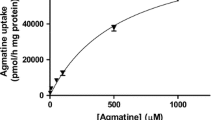Abstract
Polyamine transport plays an important role in the homeostatic regulation of the polyamine levels. In animals, dietary polyamines are absorbed efficiently in the intestinal tract. In the colon, luminal bacterial derived polyamines are important contributors to cellular polyamine contents. Polyamine transport involves unique uptake and export mechanisms. The amino acid transporter SLC3A2 acts as a polyamine exporter in colon cancer-derived cells. Polyamine uptake is mediated by caveolin-1 dependent endocytosis. The K-RAS oncogene signals increased polyamine uptake and decreased polyamine export. Here, we describe the methods of polyamine transport analysis in the colon and the small intestine using membrane vesicles, culture cells, and mouse models.
Access this chapter
Tax calculation will be finalised at checkout
Purchases are for personal use only
Similar content being viewed by others
References
Larqué E, Sabater-Molina M, Zamora S (2007) Biological significance of dietary polyamines. Nutrition 23:87–95
Bardocz S, White A, Grant G, Brown DS, Duguid TG, Pusztai A (1996) Uptake and bioavailability of dietary polyamines. Biochem Soc Trans 24:226S
Nakaike S, Kashiwagi K, Terao K, Iio K, Igarashi K (1988) Combined use of alpha-difluoromethylornithine and an inhibitor of S-adenosylmethionine decarboxylase in mice bearing P388 leukemia or Lewis lung carcinoma. Jpn J Cancer Res 79:501–508
Wery I, Kaouass M, Deloyer P, Buts JP, Barbason H, Dandrifosse G (1996) Exogenous spermine induces maturation of the liver in suckling rats. Hepatology 24:1206–1210
Hessels J, Kingma AW, Ferwerda H, Keij J, van den Berg GA, Muskiet FA (1989) Microbial flora in the gastrointestinal tract abolishes cytostatic effects of alpha-difluoromethylornithine in vivo. Int J Cancer 43:1155–1164
Quemener V, Moulinoux JP, Havouis R, Seiler N (1992) Polyamine deprivation enhances antitumoral efficacy of chemotherapy. Anticancer Res 12:1447–1453
Uemura T, Yerushalmi HF, Tsaprailis G, Stringer DE, Pastorian KE, Hawel L, Byus CV, Gerner EW (2008) Identification and characterization of a diamine exporter in colon epithelial cells. J Biol Chem 283:26428–26435
Belting M, Mani K, Jonsson M, Cheng F, Sandgren S, Jonsson S, Ding K, Delcros JG, Fransson LA (2003) Glypican-1 is a vehicle for polyamine uptake in mammalian cells: a pivital role for nitrosothiol-derived nitric oxide. J Biol Chem 278:47181–47189
Roy UK, Rial NS, Kachel KL, Gerner EW (2008) Activated K-RAS increases polyamine uptake in human colon cancer cells through modulation of caveolar endocytosis. Mol Carcinog 47:538–553
Igarashi K, Ito K, Kashiwagi K (2001) Polyamine uptake systems in Escherichia coli. Res Microbiol 152:271–278
Uemura T, Kashiwagi K, Igarashi K (2005) Uptake of putrescine and spermidine by Gap1p on the plasma membrane in Saccharomyces cerevisiae. Biochem Biophys Res Commun 328:1028–1033
Uemura T, Kashiwagi K, Igarashi K (2007) Polyamine uptake by DUR3 and SAM3 in Saccharomyces cerevisiae. J Biol Chem 282:7733–7741
Uemura T, Tachihara K, Tomitori H, Kashiwagi K, Igarashi K (2005) Characteristics of the polyamine transporter TPO1 and regulation of its activity and cellular localization by phosphorylation. J Biol Chem 280:9646–9652
Uemura T, Tomonari Y, Kashiwagi K, Igarashi K (2004) Uptake of GABA and putrescine by UGA4 on the vacuolar membrane in Saccharomyces cerevisiae. Biochem Biophys Res Commun 315:1082–1087
Schaub T, Ishikawa T, Keppler D (1991) ATP-dependent leukotriene export from mastocytoma cells. FEBS Lett 279:83–86
Saxena M, Henderson GB (1995) ATP-dependent efflux of 2, 4-dinitrophenyl-S-glutathione. Properties of two distinct transport systems in inside-out vesicles from L1210 cells and a variant subline with altered efflux of methotrexate and cholate. J Biol Chem 270:5312–5319
Acknowledgements
We would like to thank Dr. Kirk E. Pastorian, Dr. Leo Hawel III, and Dr. Craig V. Byus, Department of Biomedical Sciences, University of California, Riverside, for development of the putrescine tolerant CHO cells. We thank Dr. B. Sloane and Dr. D. Cadavello-Medved, Department of Pharmacology, Barbara Karmanos Cancer Institute, Wayne State University, School of Medicine, for providing HCT116/Mock and HCT116/Cav-1 A. S. cells. This work was supported, in whole or in part, by National Institutes of Health Grants CA123065, and CA095060.
Author information
Authors and Affiliations
Corresponding author
Editor information
Editors and Affiliations
Rights and permissions
Copyright information
© 2011 Springer Science+Business Media, LLC
About this protocol
Cite this protocol
Uemura, T., Gerner, E.W. (2011). Polyamine Transport Systems in Mammalian Cells and Tissues. In: Pegg, A., Casero, Jr., R. (eds) Polyamines. Methods in Molecular Biology, vol 720. Humana Press. https://doi.org/10.1007/978-1-61779-034-8_21
Download citation
DOI: https://doi.org/10.1007/978-1-61779-034-8_21
Published:
Publisher Name: Humana Press
Print ISBN: 978-1-61779-033-1
Online ISBN: 978-1-61779-034-8
eBook Packages: Springer Protocols




